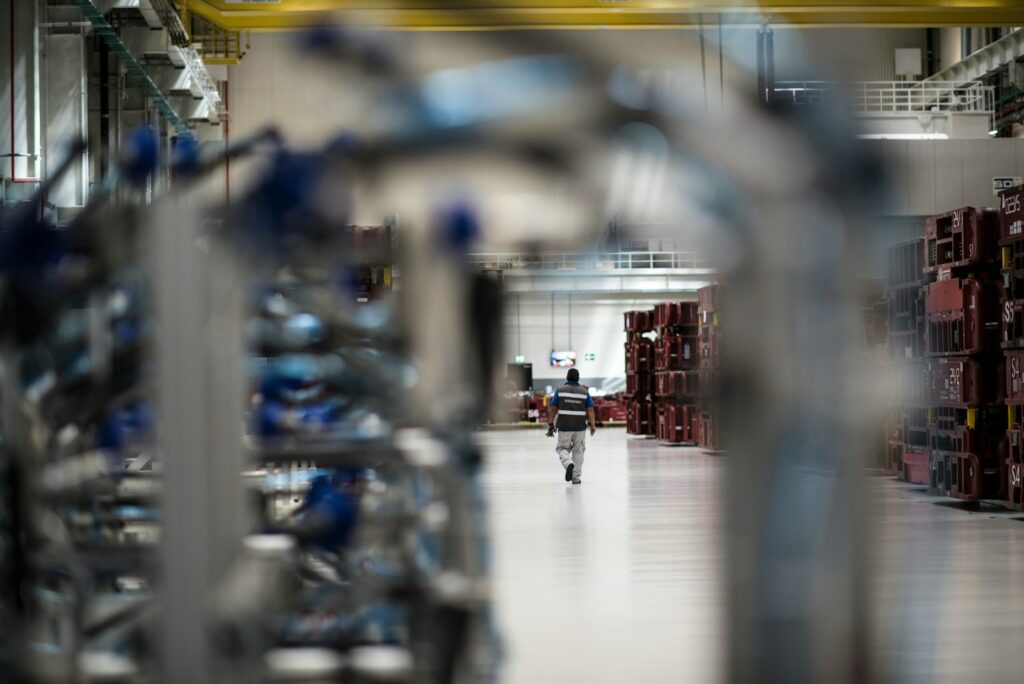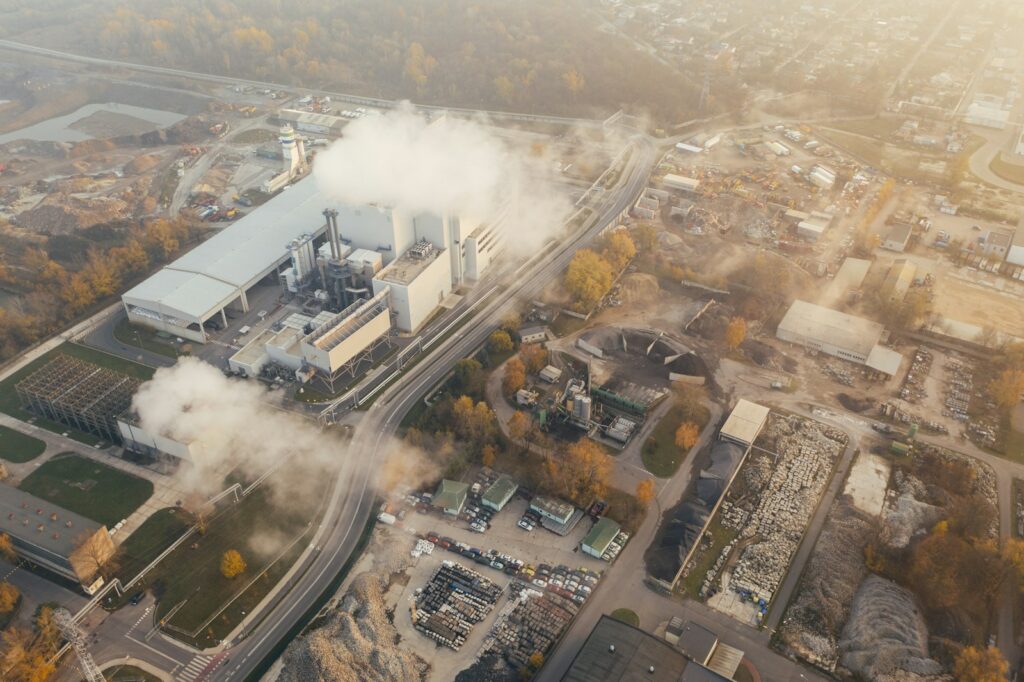The Metaverse has entered a spike in popularity from an initial surge of overinflated expectations following numerous permutations of What is the Metaverse? Something par for the course for transformative technologies.
Yet, what has been lost in the noise and general conception of the metaverse is the practical and broader perspective the metaverse contains.
Thus, The Metaverse Insider will provide a definition of the Metaverse into something easily grasped but hard to master. An explanation that tears down the diffuse science fiction and provides real value derived by businesses, industries, governments, and people. Similarly, this feature-length article will act as the center of a web, linking you to detailed deep dives when you encounter a metaverse topic you are interested in.
What is the meaning of Metaverse?
“Metaverse” is composed of two words: Meta and verse.
The latter is straightforward and is a slimmed version of “universe”, meaning a large world.
‘Meta’, on the other hand, was used by the ancient Greeks to refer to something either beyond, after, or behind something. In our case, ‘Meta’ in Metaverse refers to beyond, i.e., beyond the universe or a second world.
In his book, The Metaverse, Matthew Ball highlights the confusion in 2021 surrounding the Metaverse from a struggling CNBC Jim Cramer, attempting to explain the metaverse to investors: “You have to go to the Unity conference call first quarter, which really explains what the Metaverse is, which is the idea that you you’re, you’re, you’re looking at basically you can be in Oculus, whatever. And you say, I like the way that person looks in that shirt. I want to order that shirt and it’s or ultimately it’s an NVIDIA uh, based on NVIDIA. And when I was out at NVIDIA with Jensen Huang, what happens? You could, it’s conceivable. Okay. David, listen to me. Cause this is important.” (source)
Today the virtual picture is clearer. Yet still, defining the Metaverse is dichotomous, contentious, and comes with heavy baggage.
The reason is the Metaverse can be distinguished into two categories: the current nascent but more practical metaverse. And the prospective Metaverse, a dystopian or utopian, depending on your proclivity towards deep technology.
Let’s begin with the prospective Metaverse.
The Nine Pillars of the Metaverse
The author, Neal Stephenson, who coined ‘Metaverse’ in his book Snow Crash from 1992, deemed today’s Metaverse nascent due to nine lacking infrastructure pillars defined by Matthew Ball as:
- Virtual Worlds refer to the Metaverse as naturally being digital.
- Likewise, 3D means the digital Metaverse must be comprised of 3D environments.
- Real-Time Rendered means the digital 3D Metaverse must be continually developed and experienced. It is equivalent to the Metaverse being a continual online experience.
- Next, the Metaverse must be Interoperable which means the multiple subsections or worlds of the Metaverse are tracked interdependently.
- Naturally, similar to massively multiplayer online games, the Metaverse must be Massively Scaled and able to house entire population centers.
- Similar to when something is created or new in the Metaverse, these changes must be Persistent and ever-changing.
- In fact, these changes must be experienced and shared everywhere in the Metaverse – they must be Synchronous.
- Similar to 3D, users of the Metaverse must get a sense of Individual Presence which means a feeling of individuality and immersion.
- Finally, for a Metaverse to mirror the real world: Continuity Of Data is paramount. When buying something in the Metaverse, data must detail that it is you, not someone impersonating you, purchasing that digital item.
How do we Define the Metaverse?
You just read the technical definition of the Metaverse. Conceptually, the Metaverse is an embodied 3D world you can establish a second life. It thus contains numerous intricate patterns of genuine living spanning social interactions, economics, culture and everything in between. In fact, this definition originates from a SciFi novel that was adopted by Meta.
Recently, Apple announced its vision and differing philosophy of the Metaverse to be Spatial Computing. A distinct difference between humanizing advanced technology and bringing immersive tech to practical uses to create and connect: not an immersive world you step into.
Bringing the Metaverse into Reality
As the technical and conceptual definitions are diffuse, The Metaverse Insider splits the current Metaverse into three parts which intersect to form practical use cases:
- Social Metaverse
- Enterprise Metaverse
- Industrial Metaverse
The three categories comprise the Metaverse of three distinct and overlapping subsections. Each section is categorized with its own identifiers, sectors, and use cases while overlapping to form numerous solutions the Whateververse as a whole encompasses. Thereby, these points become the sections where the Whateververse will transform into the Metaverse.
Yet, today, the Metaverse encapsulates the breadth of sectors with their intricate interactions and the complex use cases they cover.
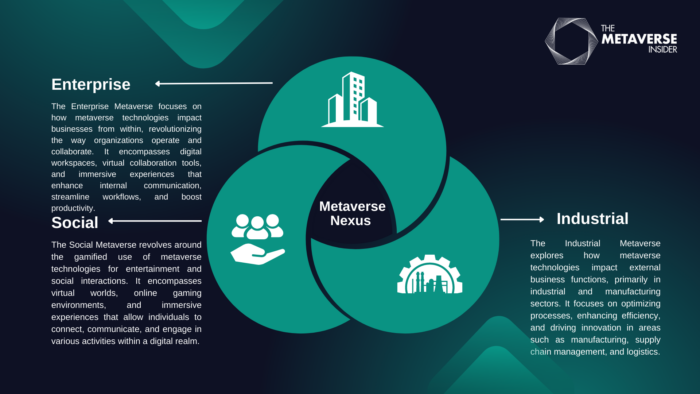
How to Access the Metaverse
As the Metaverse casts a wide virtual shadow, the question remains of how to access it. And so, entering the Metaverse depends on what subcategory you are after. So while you don’t need a virtual or augmented reality headset as the gateway, in most cases, it is recommended.
How to Access the Social Metaverse?
As the Social Metaverse is focused on social interactions and entertainment, you can access such virtual worlds through an internet browser like The Sandbox or a dedicated VR application like VRChat. Although some Social VR worlds exist, like Somnium Space or Horizon Worlds. Similarly, the Social Metaverse also exists in the blending between worlds. A space dominated by WebAR experiences like Pokémon GO or AppAR applications like Snapchat’s live filters. In this case, you can access it through your smartphone.
You can read in more detail how to access the Social Metaverse and the devices needed to do so in the article below.
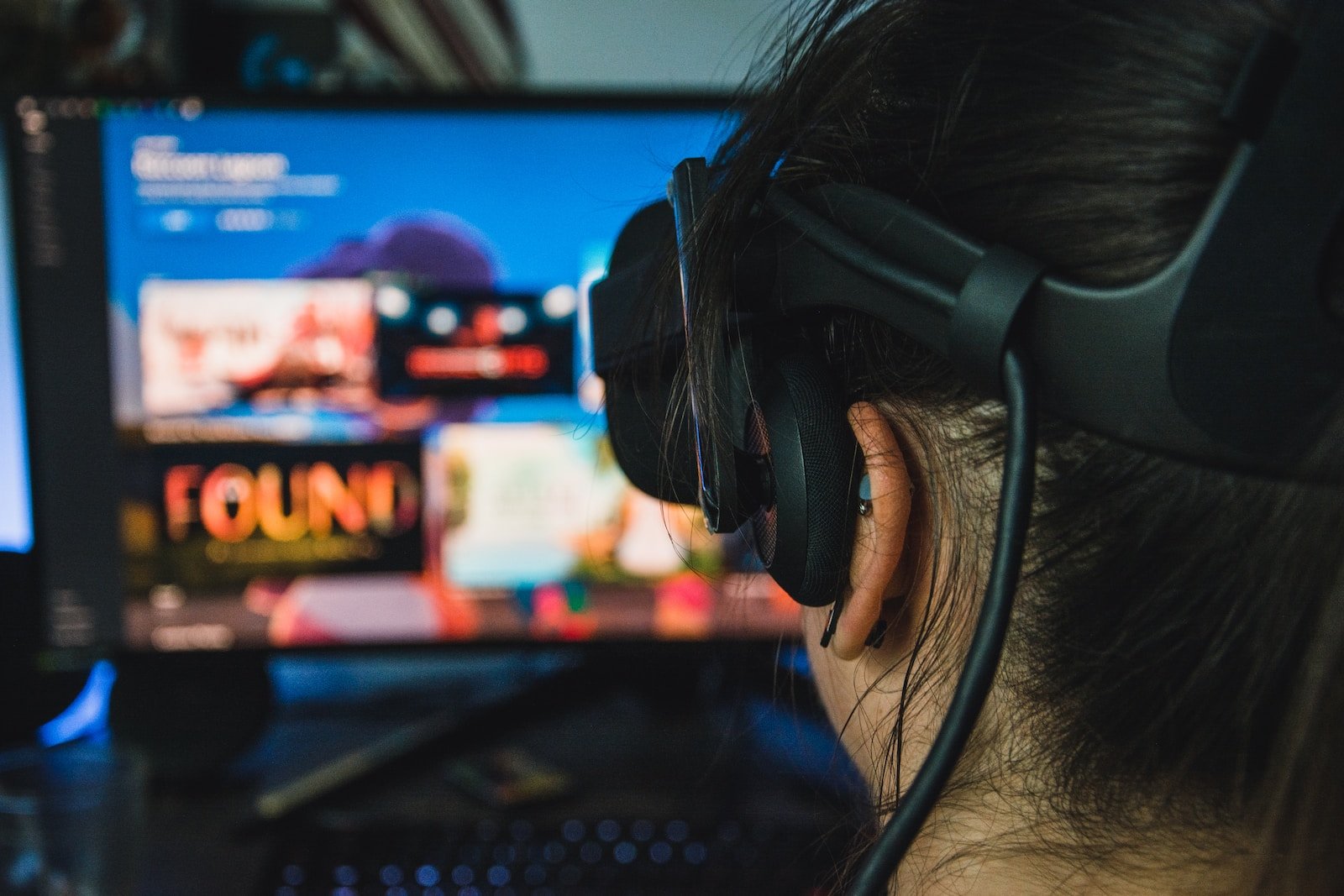
How to Access the Industrial and Enterprise Metaverses?
You access the Enterprise and Industrial Metaverses through a browser client, smartphone, tablet or computer application, or immersive technologies. However, the Industrial and Enterprise Metaverses differ from the customized development required per business entity using Software Development Kits (SDKs) or APIs (Application Programming Interfaces).
For example, in the Industrial Metaverse, an advanced Digital Twin of a factory complex can be designed, developed, and managed through NVIDIA’s Omniverse. Whereas a virtual workroom can be accessed through Meta’s proprietary VR workspace Metaverse called Horizon Workrooms or the same enterprise metaverse world able to be accessed through a browser client in 2D, or a tailored enterprise metaverse mixed reality applications like Immersed able to add virtual monitors to your desk setup.
We are also seeing businesses partner or build their own Enterprise and Social Metaverses intersections, such as Hyundai Motor’s Downtown, a customer experience center to promote the car brand’s values and future plans for mobility.
The History of the Metaverse
First, a helpful prism to view our relationship with communications technologies is the human desire for collaboration and information, harkening back to before language.
See, language was the first step humanity took on the staircase toward human advancement. It simply enabled us to share experiences and insights through abstract words. Any subsequent steps, like the printing press and the Metaverse, are the natural evolution of pushing communication to be ever more instantaneous and natural while making information perpetual and broadly accessible.
When that is said, here are the useful historical looking-glasses to peer the Metaverse through.
The Waves of Computing and Connection
The first wave began in 1959 when the first mainframe computer – nicknamed Big Iron – was built by IBM and called the brandable name “The IBM 1401 Data Processing System”.
Interestingly, despite the archaic hardware, mainframe computers are still used today as servers powering the internet.
Before the second wave of computing changed everything, a researcher named Ivan Sutherland and his student Bob Sproull, 1968, released the first mixed reality headset, ironically called “Sword of Damocles”.
It was a clunky and heavy contraption that had to be strung from the ceiling to be worn in a fixed place. The experience was rudimentary yet marked the first wave of virtual reality. After, VR advanced but never broke the mainstream due to technological barriers.
Then, the second wave of computing kicked off in 1981, when hardware shrank, enabling families and businesses to own Personal Computers (PCs). Bringing a cornucopia of changes to how we play, create, work, and socialize.
Between the second and third wave of computing, Web 1.0, the read-only internet, sprang into existence from the work of CERN, DARPA, and a British chap named Tim Berners-Lee. The reason for the read-only moniker was the limited user-generated content that defines our current Web 2.0 today. Because from the early 2000s, advancements in server technology, programming skills, and coding languages ushered in the interactive and user-generated internet we enjoy and struggle with today.
A seismic shift happened, yet again, in 2007, marking the third wave of computing delineated by mobile. Further shrinking computing hardware into handheld devices and changing the mantra of ‘going to be connected’ to ‘always connected’.
After this mobile boom, virtual reality resurfaced with the successful crowd-funding campaign that released the first mass-produced VR headset: the Oculus Rift, in 2012. This headset pushed virtual reality to be viable and prompted Facebook to acquire Oculus in 2014, supercharging immersive technologies into the second wave of VR we still are residing in today.
Shifting our view to augmented reality then the term was birthed in 1992 by researchers. But it was in 2014 when a significant push of AR ended up in a Western slump with Google Glass. A wearable assisted reality smartglass failing from poor consumer adoption and privacy concerns: so the AR glass pivoted towards enterprises. In fact, industries and enterprises, up until then, had been using augmented reality for operations since the years prior.
AR headsets and glasses continued to be shaped by the negative conception of Google Glass until Magic Leap broke through it with the Magic Leap 1 in 2018, and Microsoft a year later released the HoloLens 1. Since then, AR continues to evolve on smartphones through WebAR and AppAR, in industries through assisted reality, and in advanced AR headsets used for Design & Development.
But like humanity’s continual search to make communication natural and information perpetual, the first to the third wave of computing transformed from tapping on keyboards to touch-sensitive glass to spatial spaces where we operate computing in 3D together. A fourth wave is delineated by either the Metaverse or Spatial Computing, depending on which tech bro you ask.
Metaverse Under Construction
When you imagine the Metaverse, its reality right now is a yellow construction sign with black bold lettering saying: “Metaverse Under Construction”, dated 22 July 2021.
Because on that day, Mark Zuckerberg, Facebook founder and CEO, publicly announced: “In this next chapter of our company, I think we will effectively transition from people seeing us as primarily being a social media company to being a metaverse company.”
After which several billion US dollars was and is continually invested into software platforms of Horizon Worlds and Horizon Workrooms, and hardware innovation through Reality Labs. The formation of a Facebook (Meta) led social Metaverse began.
Roughly at the same time, Microsoft announced the legacy tech giant to be the leader in an Enterprise Metaverse taking advantage of the company’s extensive productivity and software infrastructure platforms.
A year later, NVIDIA released its real-time 3D (RT3D) development platform Omniverse paving the way for the Industrial Metaverse.
However, the Metaverse term has turned contentious, with other terms like Apple’s Spatial Computing gaining ground.
In fact, we are seeing a shift from virtual worlds with cryptocurrencies and NFTs towards a multifaceted view of the Metaverse.
Key Metaverse Technologies
Immersive Technology
Also known as Extended Reality (XR), Immersive Technology is an umbrella term covering all the reality technologies used for spatial computing.
The crucial aspect of XR is the constant pursuit of implementing as much processing power and unique features into a slim and lightweight body as possible.
So while some manufacturers focus on using premium functionality and usabilities like Varjo or accessibility and high adoption like Meta or humanizing advanced technology into practical uses like Apple. All follow the law of ‘more power into smaller footprints’.
Generally, XR covers virtual and augmented reality.
Virtual Reality
Virtual Reality (VR) headsets fully enclose and immerse the user into a digital reality. Metaphorically, it is like strapping a personal and interactive movie theater on your face. Likewise, VR headsets come in three different forms: Standalone VR, PC VR, and Smartphone VR.
- Standalone VR headsets feature all processing and battery internally, enabling them to be portable VR devices.
- PC VR headsets must be tethered to a computer to function, limiting mobility but vastly increasing computational power.
- Smartphone VR headsets are the most affordable and are canisters you place your smartphone in to create a rudimentary virtual reality experience.
Further, VR headsets can be segmented into where the tracking of movements originates and how elaborate it is.
First is 6 versus 3 Degrees of Freedom (DoF).
- 3DoF refers to the ability to move in three rotational axes: up/down and left/right. 3DoF is also called sedentary VR, as you can’t get up and move around.
- 6DoF incorporates the three rotational axes but then implements three transitional axes as well, enabling you to move forward/backward, left/right, and up/down using your entire body.
Second is where the tracking of the degrees of freedom originates, in which two options exist.
- Outside-in tracking refers to external tracking stations forming an area where the user can move around and be tracked in real time.
- Inside-out tracking is the opposite, where tracking stems from the VR headset itself and tracks both movements and the shifting environment as the user walks around.
A recent trend in VR headsets is the implementation of Mixed Reality (MR).
In a nutshell, VR headsets with MR capabilities turn into augmented reality (AR) headsets. Briefly, VR headsets enable AR by live filming what our eyes would normally see and mirroring it in real-time on the display inside the VR headset. Then, using advanced tracking methods, the user in a VR headset can interact with and overlay digital elements in the real world.
Augmented Reality
AR comes in two forms, WebAR/AppAR, and premium AR. WebAR/AppAR are rudimentary augmented reality experienced through a smartphone or tablet using GPS-like systems to map where the user is or a physical marker recognized by the WebAR or AppAR device.
A great example of location-based WebAR is Pokémon GO. Whereas marker-based AppAR is Instagram and Snapchat filters.
Alternatively, Augmented Reality can be experienced through premium AR headsets such as HoloLens 2 or Magic Leap 2. These are headsets the user places on their head with holograms projected onto see-through glass, enabling the user to interact and manipulate digital elements as part of the real world.
Assisted Reality
A subcategory of augmented reality is assisted reality. Briefly, assisted reality is what WebAR and AppAR are with providing a digital overlay displayed on see-through glass. However, the content does not interact or morph into the real world: it is static. Assisted reality is usually experienced through AR Glasses from brands like Vuzix, RealWear, and Nreal.
Digital Twins
Digital Twins are 1:1 virtual replicas of physical systems or objects. These can be a Digital Twin of a car factory where simulated tests can be executed for new car designs or to introduce a new production node into a complex manufacturing system. But a digital twin can also be on entire cities to aid with economic development or urban planning. These industrial digital twins are the most advanced aspect of the Industrial Metaverse, incorporating numerous enabling technologies and containing many more use cases.
Internet of Things
Internet of Things (IoT) is when traditional items like street lamps, fridges, trash bins, and so on are connected to the internet, exchanging information with each other.
Big Data
The Internet of Things (IoT) provides an abundance of data. In fact, the more IoT devices an entity has, the more complex its dataset and subsequent information extraction, leading to effective decisions.
Big Data can be conceptualized into Three V’s:
- The velocity for which data is created,
- the volume of information gathered,
- and the variety of data covered.
5G
Interestingly, what generally (unless IoT devices are isolated within an enterprise or industry called Edge Computing, see below) connects IoT will be 5G for its substantially greater bandwidth. Further, 5G is the fifth generation cellular internet accessed on the go by devices like smartphones, computers, and standalone VR and AR glasses and headsets.
NFTs
Non-Fungible Token (NFT) is a method for digital elements to be exclusive and non-replicable. So, in the same way, a physical painting is wholly unique and cannot be copied (without legal action), an NFT can turn a picture or video into a digital ‘painting’ upholding its value. This doesn’t mean the image or video cannot be copied, but the copied version won’t have the authentic stamp of originality.
Blockchain
Blockchain is an encryption or ledger technique where information is encrypted and stored into blocks linked with other blocks through a chain – hence the name. Effectively, Blockchain enables computers to securely share and store information in an open-source decentralized network. The benefits of Blockchain are the decentralized structure, which means no middleman is required, saving cost and time. Also, the information stored is immutable, which means it cannot be destroyed or tampered with.
Cryptocurrency
One of the concepts enabled by Blockchain is cryptocurrencies. These are digital money any entity can develop and safely distribute and use. Thus, a Social Metaverse can reside over its own cryptocurrency such as The Sandbox’s SAND, using Blockchain to safely conduct transactions of, for example, a digital shirt converted to an NFT. Yet, cryptocurrencies have also been adopted by enterprises like Facebook’s (Meta) Diem cryptocurrency.
Edge Computing, HPC, Quantum Computing
First, Edge Computing is when an entity sets up a local internet to be accessed safer and quicker. When done, connected devices, like IoT, still function even when an online connection is lost, while response times are much faster between devices, and less costly to transfer data between them. Edge Computing is generally used in digital twins.
Next, high-performance computers (HPC) are exaggerated and oversized versions of traditional computers. Thus, HPCs hold many more processing units in a massive computer or are linked wirelessly through high-speed internet compared to traditional computers.
Finally, Quantum Computing still fundamentally functions the same way as traditional computers: that is operating from the language of bits. Briefly, bits are 1s and 0s that form the basis of any programming language. But where traditional computers hold numerous transistor gateways which open and close to produce either a 1 or 0. Quantum computers can both be a 1 and a 0 simultaneously called qubits. Further, quantum computers’ qubits can communicate instantaneously with each other through the woo-science of quantum mechanics. Consequently, quantum computers are exponentially faster than traditional computers, promising a quantum leap in computational ability.
Artificial Intelligence
At the core, AI is an adaptive and self-learning system that can reason and compute complex requests and datasets. Often generative AI – AI capable of creating something unique – is built on neural networks. And neural networks function similarly to how our brains work with complicated and complex interconnected small bits of information that emerge to form something more diffuse like memories and consciousness. For example, the lauded ChatGPT from OpenAI is built on a neural network infrastructure but trained through a Large Language Model (LLM). An LLM is an obscene amount of linguistic information stored online, and ChatGPT is said to function based on over 1 trillion bits of information. Thus the AI of ChatGPT is trained to mirror the human brain by computing over 1 trillion pieces of information online based on our human collective consciousness.
Naturally, all these technologies intersect and synergize in different ways to form the current Metaverse and future Metaverse.
Metaverse Sectors
Enterprise Metaverse
The Enterprise Metaverse focuses on how metaverse technologies impact businesses from within, revolutionizing the way organizations operate and collaborate. It encompasses digital workspaces, virtual collaboration tools, and immersive experiences that enhance internal communication, streamline workflows, and productivity optimization. By leveraging the Enterprise Metaverse, businesses can optimize their operational efficiency, improve decision-making processes, and foster innovation within their teams. This domain offers a range of solutions to enhance core business functions and drive organizational growth.
Social Metaverse
The Social Metaverse revolves around the gamified use of metaverse technologies for entertainment and social interactions. It encompasses virtual worlds, online gaming environments, and immersive experiences that allow individuals to connect, communicate, and engage in various activities within a digital realm. The Social Metaverse offers new avenues for socialization, community building, and shared experiences, transcending physical boundaries and enabling people to connect and interact in ways previously unimaginable. It serves as a platform for entertainment, self-expression, and creative exploration.
Industrial Metaverse
The Industrial Metaverse explores how metaverse technologies impact external business functions, primarily in the industrial and manufacturing sectors. It focuses on optimizing processes, enhancing efficiency, and driving innovation in areas such as manufacturing, supply chain management, and logistics. The Industrial Metaverse enables industries to leverage digital twins, simulate real-life infrastructure, and create virtual environments for testing and prototyping. By embracing the Industrial Metaverse, businesses can streamline operations, reduce costs, and increase sustainability, ultimately driving enhanced productivity and competitiveness in the industrial landscape.
Metaverse Market Map and Size
Metaverse Market Map
While the Metaverse is comprised of the elements of Social-, Enterprise-, and Industrial. The Metaverse market map we developed is conceptualized into Economy, Infrastructure, and User Experience.
The Economic part of the market map is underpinned by Blockchain giving birth to decentralized finance of cryptocurrencies and Non-Fungible Tokens (NFTs), or changes in economic infrastructure as evidenced by IBM Food Trust®. Essentially linking all supply and processing nodes onto a collaborative and hybrid Blockchain system.
Leading us to the Infrastructure part of the Metaverse market map. The infrastructure of the metaverse is the means of accessing the three elements with the supporting hardware and software realizing and driving them. The innovative hardware technologies are described earlier in this article.
User Experience refers to the specific use cases the Metaverse opens. Briefly, use cases between the three distinct metaverses can be:
- Digital fashion items turned into NFTs backed by blockchain to be created, bought and resold in the Social Metaverse.
- Enterprises using Immersive Learning for training and onboarding new employees or upskilling and reskilling existing ones through virtual and augmented reality.
- Realistic replicas of a Digital Twin factory complexes used for optimization, evaluation, machine-computer-worker flow and collaboration, and more.
The Metaverse market map is significantly more complex and holds numerous use cases which shape itself. See our in-depth article on the Metaverse market map below.
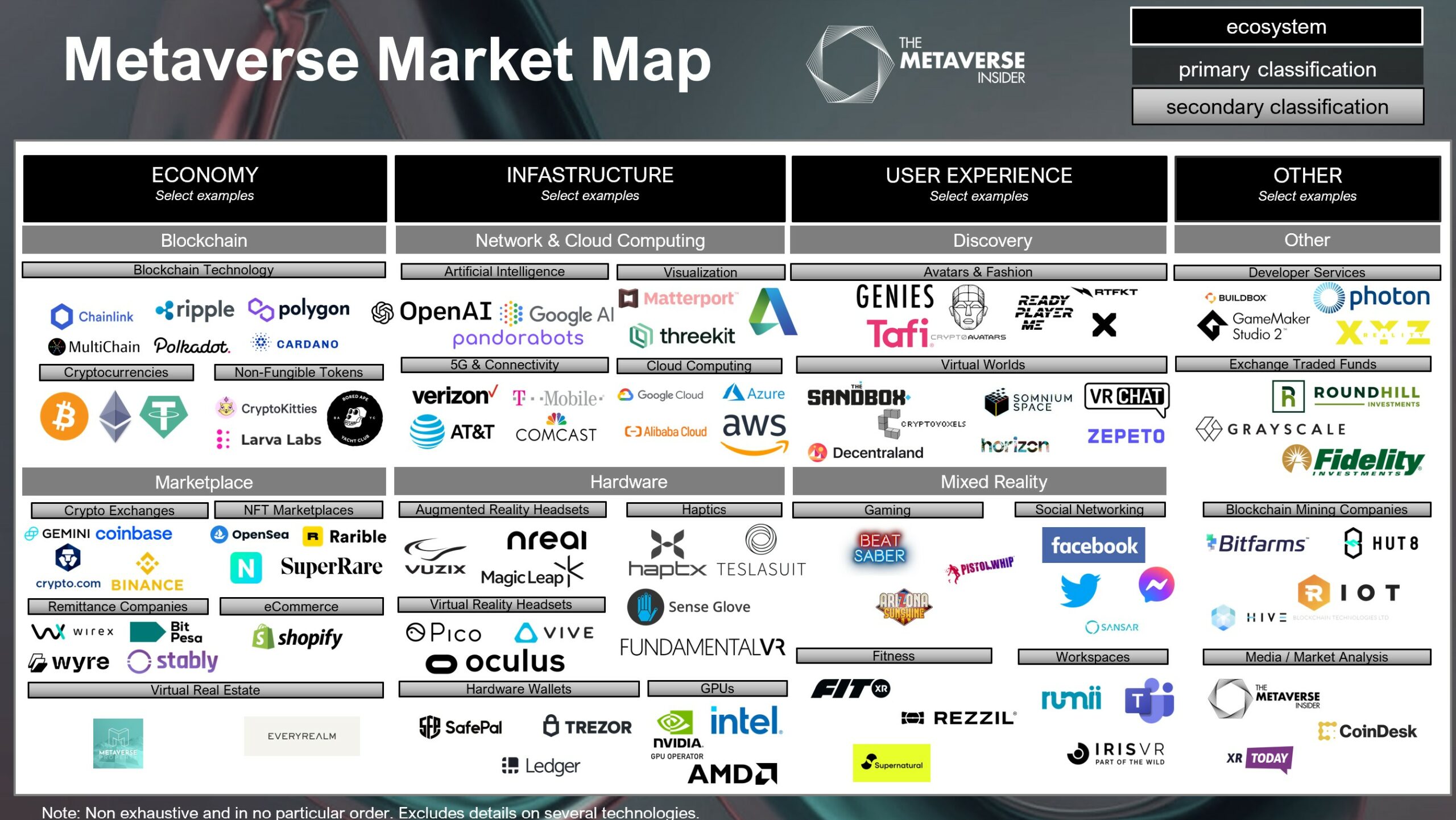
Metaverse Market Size
The Metaverse comprise transformative solutions for how we make, work, socialize, or play. Similarly, each Metaverse emerged from technologies introduced in the past year to technologies with over half a century of advancement. But despite this amalgamation of seasoned and contemporary technologies, the three Metaverse sectors have and will continue to experience proliferation and expansion in use cases, maturity, and adoption. And while it is a contentious topic, the Metaverse is pegged to achieve a market size and valuation between $800 billion and over $13 trillion by 2030, with an average estimation of $5.8 Trillion.
Discover how all this fits together in more detail and how this valuation range is arrived at below.
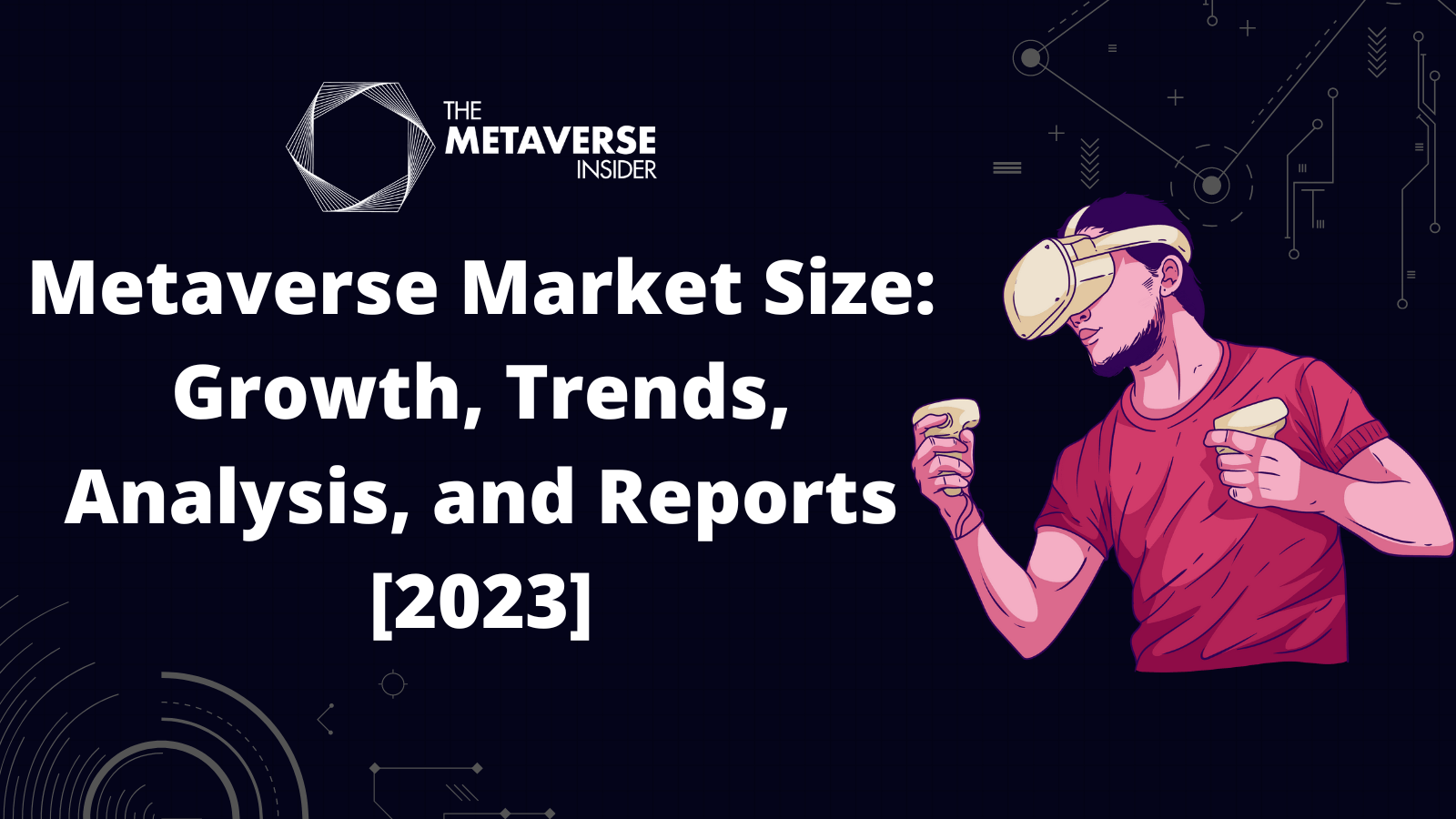
Most Important Metaverse Companies
Our proprietary business intelligence platform tracks over 2,000 companies driving the growth of the Metaverse. However, seven key companies stand out as trailblazers, providing the essential infrastructure for the Metaverse.
Meta Platforms
Formerly known as Facebook, Meta Platforms emerged as a pivotal player and catalyst, defining the second wave of virtual reality. Oculus initially started as a crowd-funded company, but when Facebook acquired it, a clear message was sent to the world: the metaverse was not a mere gimmick but a transformational technology set to revolutionize the way we play, socialize, create, and work.
Now, with the name change to Meta and numerous metaverse-focused executive hires, Meta is pushing the future of the Metaverse through three pivotal pillars: relentless innovation in immersive technology via RealityLabs, the release of affordable VR and mixed reality headsets, and Social and Enterprise Metaverse platforms such as Horizon Worlds and Horizon Workrooms.
For better or worse, Meta has become the Metaverse mascot.
See also: What is The Facebook Metaverse & How Bright Is Its Future?
NVIDIA
In addition to NVIDIA’s expertise in designing and manufacturing graphical processing units, the company is also pushing the development of real-time 3D (RT3D) content through its platform, Omniverse. Notably, Omniverse is used for Industrial Metaverse success cases such as Bentley Systems, and a BMW manufacturing complex developed as an industrial digital twin.
Unity Technologies
As a competitor to Omniverse, Unity Technologies also fosters developer platforms for creating real-time 3D (RT3D) content for Metaverse use cases. The developer tool, called Unity Forma, is tightly interwoven with real-time data models to dynamically transform the 3D content, much like Omniverse. For example, you can read about an expansive digital twin success story of replicating Vancouver International Airport (YVR) featured in our in-depth Metaverse Marketing Guide white paper.
Epic Games
In April 2022, Epic Games notably raised over US$2 billion to build its version of a Social Metaverse, clearly indicating that it is one of the key companies advancing the Metaverse. Furthermore, Epic Games is uniquely positioned to push a multi-platform Social Metaverse from its game turned pop culture phenomenon Fortnite, accessible through multiple gaming platforms, and its advanced game engine Unreal, enabling the creation of immersive experiences.
Apple
Before the seminal announcement of Apple Vision Pro in June 2023, Apple was one of the key players in augmented reality, from housing the largest AR app store. In fact, through the iPhone and iPad, WebAR and AppAR matured and opened opportunities for immersive commerce, like the groundbreaking AR app: IKEA Place.
But, when Apple announced the Apple Vision Pro, an advanced and premium mixed reality headset, the metaverse got introduced to a redefinition towards Spatial Computing. A change in philosophy focused on making immersive technology approachable, human, and practical. Nevertheless, Apple’s entry into the metaverse hardware arena, through the “Apple Effect,” increases the legitimacy of the metaverse and its market size.
Google was a pioneer in AR glasses with Google Glass. And while the consumer product was discontinued due to low adoption and privacy concerns, the enterprise version, Google Glass Enterprise, continues to be embraced by businesses for the Enterprise Metaverse. However, Google will stop supporting the enterprise AR glass in Fall 2023.
Finally, based on new hires and leaked code, Google is rumored to be developing an AR operating system for consumer AR glasses and a Play Store for AR apps. Clearly, Google Metaverse is preparing for the inevitable surge in AR glasses in Western markets by gauging the popularity of consumer AR glasses in East Asian markets.
PICO & ByteDance
Speaking of the Far East, PICO, a commendable VR and mixed reality headset manufacturer, which releases feature-rich and affordable reality devices, much like Meta. PICO has also achieved a market-leading position in Europe by partnering with local suppliers.
But it was after the acquisition of PICO by ByteDance in 2021, the conglomerate also overseeing TikTok, it became a notable player to spur on the Metaverse. Especially with the recently released competitor to Horizon Worlds called Pico Worlds.
Microsoft
The last of our highlights is Microsoft, which provides infrastructure for the Enterprise and Industrial Metaverse through hardware and software. First, Microsoft Metaverse is pushing the boundaries of advanced augmented reality through the AR headsets HoloLens 1 and 2, even offering specialized versions of HoloLens 2 for industrial cleanrooms and a modified version for the US Army.
However, it seems Microsoft is pivoting its strengths to enterprise and industrial metaverse platforms, ranging from applications like Dynamics 365 Connected Spaces to Microsoft Mesh to Azure Digital Twins.
Lastly, it is worth noting that Microsoft could be a player in the Social Metaverse arena, considering the recent attempted acquisition of the prominent games developer and publisher Activision-Blizzard, currently paused by the US Federal Trade Commission.
If you want to know the other key companies that advance the Metaverse, check out our in-depth article below.

Most Used Metaverse Platforms
The two defining metrics to gauge the popularity of a Social Metaverse, whether it is centralized or decentralized, are Daily Active Users (DAUs) and Unique Active Wallets (UAWs). While the first, DAUs, delineate the sheer consistent size of any Social Metaverse and thus determine its popularity. Unique Active Wallets (UAWs) are the transactions made within a given Social Metaverse. These two metrics form three categories determining popularity:
- High DAUs and UAWs: A leading Social Metaverse platform that boasts strong, consistent users who actively engage with the Social Metaverse’s economy.
- High DAUs and low UAWs: A popular Social Metaverse in numbers and a commendable platform for businesses to establish a presence for marketing purposes. Although less attractive for investments such as virtual real estate and unique digital items (NFTs)
- Low DAUs and high UAWs: A small Social Metaverse but with great virtual investment potential due to its thriving digital economy.
Finally, determining the popularity of platforms that provide the digital infrastructure of the Industrial and Enterprise Metaverse depends on the security and privacy level, customization support, consistent updates and added features, reliability of operations, and cross-functionality with other offline and online activities.
Here are five examples of popular platforms
within the Metaverse.
The Sandbox
Like Roblox, see below, The Sandbox metaverse is a blockchain-based decentralized gaming platform where games and virtual items are created and traded by its users using its cryptocurrency SAND. While The Sandbox can only be accessed through 2D platforms such as browser clients, the Social Metaverse platform is broadening its scope by allowing large entities like AXA Hong Kong to reside over an interactive area called Mega City 2. The Sandbox is unique from Roblox based on its virtual real estate ownership and a 3D modeling and animation tool, enabling users to build larger virtual structures like houses.
According to DappRader, The Sandbox has lower concurrent active users than Roblox hovering below 500 users with occasional spikes. Yet, The Sandbox’s virtual land ownership and broadening direction make it a Social Metaverse to keep your eyes on.
Roblox
Roblox is a blockchain-based decentralized gaming platform where the games and virtual items are created and traded by its users using the cryptocurrency Robux. While Roblox can be accessed through virtual reality, most users engage with the social world’s user-generated games via 2D platforms such as Xbox, PC, and iOS.
Roblox metaverse is one of the most popular Social Metaverse worlds, which according to Statista features 66.1 million Daily Active Users as of the first quarter of 2023, up from 42.1 million DAUs during Q1 2022.
Alien Worlds
Alien Worlds is a blockchain-based decentralized game where everything is tokenized, meaning every user-created digital item can be uniquely traded. According to DappRadar Alien Worlds currently contains over 250.000 Unique Active Wallets conducting over 10 million daily transactions. This was up from 180.000 UAWs conducting around 7.5 million daily transactions a year prior.
Decentraland
Decentraland Metaverse is a virtual reality Social Metaverse that uses blockchain to decentralize the social world for its users to create, consume, and trade digital content. Notably, Decentraland focuses heavily on developer content through dedicated Software Development Kits (SDKs) and the ability to purchase virtual land for investment, events, or permanent immersive experiences. Decentraland is a bit like The Sandbox, although it is more autonomous and free. Similar to The Sandbox, Decentraland’s active users hover around 500, and its popularity has been waning in the past year.
NVIDIA Omniverse
Moving to Enterprise and Industrial Metaverse platforms, NVIDIA Omniverse is a cloud-based real-time 3D (RT3D) development platform. In a nutshell, businesses use Omniverse to build virtual replicas of physical counterparts called digital twins using Universal Scene Description methods. The latest user numbers were from March 2022, with NVIDIA reporting over 150,000 downloads, with one being the hallmark large-scale industrial digital twin from BMW.
Microsoft Metaverse Platforms
Where Omniverse is utilized for the Industrial Metaverse, Microsoft Metaverse Platforms are used for Enterprise and Industrial Metaverse use cases. For example, Dynamics 365 Connected Spaces uses AI to simulate and track a physical location from sensors and cameras to gain unique insights and evaluate changes. Namely, Dynamics 365 Connected Spaces has been used to optimize a shopping floor with product layout and warehouse movement flow of its workers. Whereas Microsoft Mesh enables workers to virtually collaborate and share immersive experiences. Finally, Azure Digital Twins is a competitor to Omniverse.
Oculus Home
We have named this metaverse entity Oculus Home and not Horizon Worlds because Meta’s VR games and application store reside over multiple metaverse platforms.
For instance, competing against Decentraland and VRChat, Meta’s native Horizon Worlds is lacking in popularity and features but will gain significant reach and focus behind it. And where Meta’s productivity platform, Horizon Workrooms is in Beta, it will gain user numbers as time progress. Lastly, Oculus Home also houses third-party Social VR experiences such as VRChat, second-party VR games like Beat Saber, and popular third-party VR games like Superhot VR.
Lastly, what must be considered with the Oculus store is the impressive sales figures of the Oculus Quest 2, crowned as the best-selling VR headset in history, driving VR games and applications sales on its store, indirectly advancing the Social Metaverse.
Get a much deeper look into the 10 best metaverse platforms for 2023 below.

Metaverse Land, Digital Twin Cities and Virtual Real Estate to Know About
A pivotal metaverse category that will guide subsequent platforms under the Metaverse
is Digital Twin Cities. These urban digital twins use a vast array of sensors (Internet of Things) connected through the cloud (5G) and interacted using immersive technologies or other devices.
A successful example of an Urban Digital Twin is Orlando, Florida. A huge digital twin project spanning over 800 square miles that has been digitally mapped and equipped with thousands of live sensors creating a real-time 3D (RT3D) model using Unity. Consequently, this immersive digital twin project provides city planners with dynamic traffic flows aiding them with new road constructions, how rainwater is diverted, how they can remodel Orlando based on sea rises, and live demographic data that aids new economic developments and infrastructure projects.
Discover all the other noteworthy Digital Twin Cities and how each uniquely differs from the others below.

Squarely, Digital Twin Cities fall under the Industrial Metaverse, whereas under the Social Metaverse, we have virtual real estate.
As alluded to in covering popular Social Metaverse platforms, virtual real estate is plots of digital land being demarked and converted into NFTs enabling them to be uniquely purchased and owned. Naturally, the investment viability of virtual land depends on the Daily Active Users and Unique Active Wallets for each Social Metaverse. Nevertheless, a McKinsey prediction estimates virtual real estate will reach $5 Trillion by 2030.
The Metaverse Platforms With The Most Potential
- Meta: Based on the overlaps between immersive tech innovation and investment, a thriving VR games platform, Social Media reach through Facebook, Instagram, and WhatsApp, native Social and Enterprise Metaverses like Horizon Worlds and Workrooms means Meta is a player to be contended with.
- NVIDIA Omniverse: While significant digital twin projects are built using Unity, the Industrial Metaverse embraces NVIDIA’s versatile Omniverse platform. We are experiencing futuristic digital twin developments that mark the beginning of the fourth industrial revolution.
- Microsoft: Expect Microsoft, with its broad portfolio of enterprise and productivity platforms, to pave the way for the Enterprise Metaverse. While adoption is gradual, more businesses will realize the value of its numerous Metaverse platforms and get on the bandwagon. We are particularly pointing out Microsoft for its significant share in OpenAI owning ChatGPT and the inevitable integration of powerful generative AI into these Enterprise Metaverse platforms.
Key Trends and Insights on the Current and Future State of the Metaverse
As the infrastructure technologies enabling the Metaverse mature, the numerous use cases spanning the Social-, Enterprise-, and Industrial Metaverse will develop and shape how we work, create, and socialize. Here are snippets of the current trends of the Metaverse and what they will transform into:
- Prominent brands will continue inventive ways to use the Metaverse for marketing purposes.
- An increased blending of physical and virtual life will develop, such as Digital Twin Cities and augmented reality product packaging.
- Virtual real estate will continue to be an investment opportunity and enterprises using the digital land for events and virtual shopping.
- Current complex industrial digital twins will begin to dynamically morph manufacturing on external data sources such as supply chain complications, raw material availability, and geopolitical risks.
- VR training and Immersive Learning will continue to mature and be adopted by every reputable business using it for onboarding, upskilling, and reskilling employees.
- Current VR headsets will continue to offer mixed reality functionalities, narrowing the gap between AR Glasses and VR Headsets to eventually become one and the same.
- Remote working has slowed down as workers have reentered the office. Yet, the hybrid model persists, and we will see further advancement of immersive workspaces with realistic avatars, and virtual workstations.
The Metaverse is dashing ahead with trends outlining what is to come. So if you are interested in the entire list of trends, check out our article below.
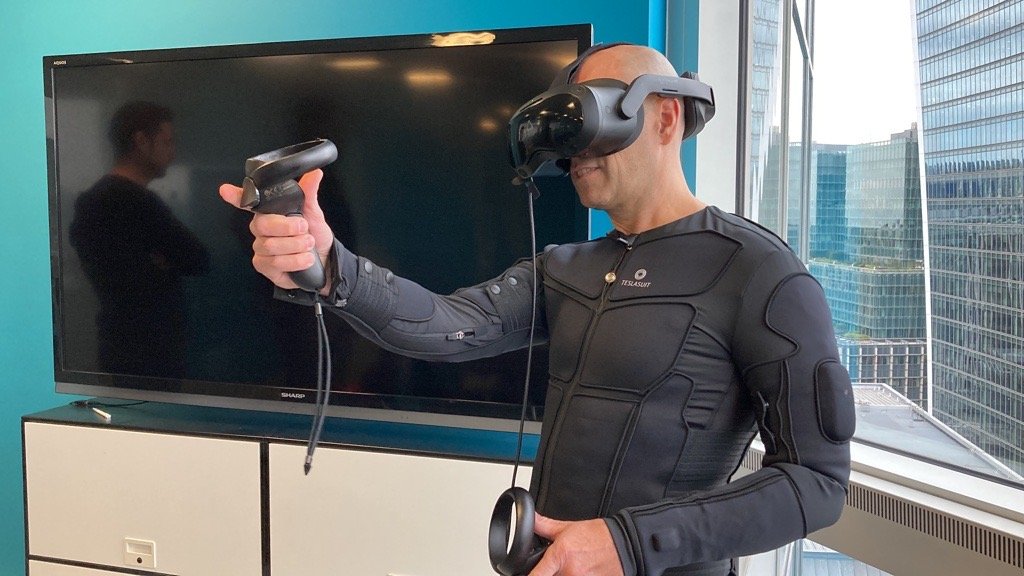
Biggest Challenges to the Future of the Metaverse
As the Metaverse matures and an increasing number of entities connect with one or more of the numerous uses, challenges will begin to present themselves and exasperate.
Here are five of the biggest ones.
- Legal: One area to be ironed out is virtual jurisdiction when digital real estate is involved. Similarly, determining which legislation to use in different disputes will also be an area that will pose complications now and in the future. Thus, we will experience a set of universally enforceable metaverse laws, norms, and principles akin to international law.
- Identifiable Information: Similar to the internet, users of the metaverse must be distinctly identifiable to rightfully interact and purchase digital elements. This will mirror the same instances concerning online and multiplayer video games for how entities are identified in possible legal disputes. Not to mention the ethical and psychological problems resulting from hiding behind an avatar.
- Privacy: As the 21st century tik-tok its way forward, we continuously experience our data and privacy encroached upon. And while it is a contentious area, establishing ourselves further in the metaverse for working, creating, and socializing the deepest levels of privacy impeachment will be possible.
- Personal invasion: Akin to Brain-Computer Interfaces like Neuralink, an increased pushback will naturally occur for people when technology starts to creep into our inner biology and lives. For example, psychologically we find wearing an Apple Watch constantly connecting us acceptable, but most will push against installing an Apple Watch on our brain stem. The same tendency might occur with the metaverse as it nears personal and biological encroachment.
- Accountability: When automated metaverse systems in the Enterprise and Industrial space malfunction and halt subsequent processes, accountability must be clear and consistent. Yet, as automated and AI-driven metaverses become intricately interwoven into complex processes, accountability is increasingly muddled.
Will there be one complete metaverse?
The metaverse is not the 3D-embodied internet envisioned by its science fiction author. It is instead more practical and complex, best conceptualized as the Metaverse. In fact, each use case embedded within the three areas or its overlapping parts is backed by innovative technologies and software solutions. So while we will see the three concentric circles inch closer, forming a solid circle – it won’t happen for years and possibly never.
Analogously, it is akin to the internet. While we determine the internet as one entity, it is used in vastly different ways from the tween playing Fortnite to the CTO budgeting an updated security system for all its devices.
Thus, the science fiction definition of the metaverse is not the current one and possibly won’t ever be. Yet with a more practical and actionable approach, the Metaverse is actively developing and delivering real value to industries, businesses, governments, and people.
FAQs
Is the metaverse currently the whateververse?
The metaverse, or as we refer to it as the “whateververse,” has emerged as a dynamic and multifaceted concept that extends beyond the initial hype surrounding NFTs and digital assets. While some companies may dismiss it as a mere buzzword, the metaverse offers far-reaching possibilities with tangible applications across industries and enterprises.
Contrary to the prevailing narrative in the mainstream media, the metaverse is gaining traction as a transformative force, challenging the status quo and paving the way for innovative use cases that go beyond the realm of virtual collectibles. Its potential impact reaches into various sectors, bringing about new opportunities and reshaping the way we interact, collaborate, and experience virtual environments.
How can you get Involved in the Metaverse?
There are numerous avenues to embrace the metaverse, catering to both individual and business interests. Here are some compelling options:
- Immersive Technologies: Embrace the metaverse by investing in cutting-edge immersive technologies such as virtual reality (VR) headsets and augmented reality (AR) devices. These tools enable individuals to dive into virtual environments, engage with digital content, and connect with others in shared virtual spaces.
- Blockchain-Based Gaming: Explore the world of blockchain-based games like The Sandbox, where participants can create, trade, and monetize virtual assets using cryptocurrency. This type of gaming experience blurs the boundaries between virtual and real-world economies, offering exciting opportunities for gamers and creators alike.
- Enterprise Applications: Businesses can harness the power of the metaverse by integrating enterprise applications into their operations. By leveraging metaverse technologies, companies can enhance internal processes, facilitate collaboration among teams, and create immersive training experiences for employees.
- Digital Twins for Industrial Work: For industrial sectors, digital twins provide immense potential for transforming businesses. Digital twins are virtual replicas of physical assets or systems, enabling real-time monitoring, predictive maintenance, and simulations. By adopting digital twins, industrial companies can optimize operations, reduce downtime, and improve overall efficiency. Platforms like Nvidia Omniverse provide great ways to access these technologies.
By embracing these avenues, individuals and businesses can tap into the vast possibilities of the metaverse and unlock new dimensions of productivity, entertainment, and innovation.
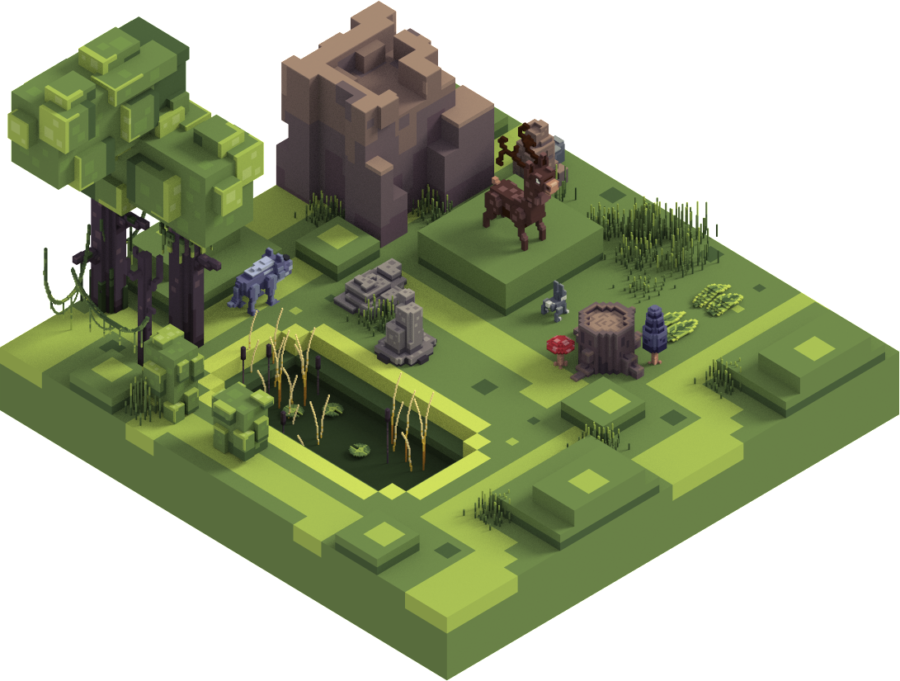

How to Keep Track on Metaverse Developments? (Intel platform)
The Metaverse Insider Intelligence platform—a comprehensive solution designed to empower your research in the rapidly evolving metaverse industry and keep you informed about the latest developments. With a cutting-edge news engine, a purpose-driven taxonomy, and state-of-the-art analytics, our data platform offers everything you need to stay ahead of the curve.














